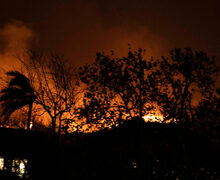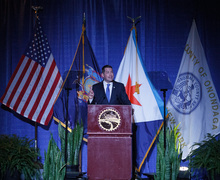Inside the creation of a football field at Yankee Stadium
Courtesy of the New York Yankees
New York Yankees grounds crew members spent weeks implementing a football field into a baseball park.
Less than an inch of grass will separate the 2018 iteration of a football field at Yankee Stadium from those of years’ past. In the last 13 games housed in the stadium, since its 2009 opening, football programs played on what DeLea Sod Farm owner Rick DeLea described as short cut grass.
DeLea’s short product, normally suited for the Yankees outfield, New York City Football Club soccer games or tee boxes on golf courses around the country, is too short for football, he said. It doesn’t have the stability for the wear and tear from the “Clydesdales,” as DeLea describes football players.
So this year, as skepticism of playing on the soccer grass rose, DeLea outsourced to Tuckahoe Turf Farms in Hammonton, New Jersey, a company which supplies five NFL teams.
“If that’s what it takes to put the right product in, for this instance, for the football game,” DeLea said, “that’s what we’re doing just to make sure the Yankees got the right field going on there.”
On Saturday afternoon, when No. 12 Syracuse (8-2, 6-2 Atlantic Coast) and No. 3 Notre Dame (10-0) walk out of their respective dugouts, a professional grade football field will span more than 50,000 square feet from home plate deep into the outfield. At the center, an estimated 35-by-45 foot Shamrock Series emblem will pop out of the grass. Field goal post netting dropped in by cranes will bookend the freshly groomed playing surface. And in Syracuse’s first top 15 matchup in 20 years, the labor of love will be one fit for the moment.
After decades of football games at Yankee Stadium, the MLB’s most successful franchise didn’t host a football game in the final 21 seasons of the old building. When the new stadium was built, it was meant to be a one sport facility, head groundskeeper Dan Cunningham said. But switching over the field has become commonplace for Cunningham and his grounds crew, who have hosted hockey games, boxing matches and concerts among other events. In 2015, the stadium became home to the New York City Football Club, an MLS franchise, and DeLea estimated the field is switched over 17-19 times per year.
“These are some big boys and they have the ability to — they can do some damage in a hurry on a field,” 30-year groundskeeper Cunningham said. “That’s something we’re not really accustomed with … it’s just a different beast. Football, to me, is very nerve racking.”
With the first football game in mid-November, field transformation started soon after the Yankees were eliminated from the playoffs in early October. The dugout railings are uplifted and decked over so the corners of the end zones can nestle in where Yankees players normally spit sunflower seeds. Cunningham and his crew taper down the infield “skin,” the term they use for the dirt comprising the basepaths.
Cunningham estimated his crew shaved off about one and one quarter inches of “skin” to accommodate for the thick cut sod. The New Jersey bred grass, known as “Gameday Sod,” by Tuckahoe Turf Farms business administrator Allen Carter Jr., is a mix that’s been tested by mimicking the field conditions of customers such as the Chicago Bears and Pittsburgh Steelers.
DeLea Sods and his crew, along with Cunningham and the Yankees grounds crew, finished matting down 375 of the 4-by-35 foot rolls last Friday, eight days before the game. DeLea compared the longer, thicker grass used this year to tree roots: The taller the tree, the deeper its roots.
On the field, the rolls are matted together by a sidekick, a large tractor-like machine that pushes each strip of grass together. Laying down the field takes about three days between his 12 workers and the Yankees crew, DeLea said.
“When our sod arrives at their stadium,” Carter said, “once it’s laid out and lined with white paint, it’s ready to be played on.”
For the most part, the painting is “kept in house” Cunningham said, as his crew lines the field and paints the iconic “N-Y” logo below home plate. But since 1996, Kunath Signs Co., a commercial sign company out of Teaneck, New Jersey, has been responsible for many lettering projects, including playoff emblems and football logos.
Kunath Signs Co. owner David Hollenbach said this year’s logo, which features the Statue of Liberty, the NYC skyline and a metro train, consists of five colors. Standard paint rollers and brushes will color center field in blue, gold, green, white and silver to make the logo pop, Hollenbach said. The day before heading to the Bronx, Hollenbach anticipated a 10-hour day for his six-to-eight man crew to fill in the logo.
Kunath also paints the emblems on the first and third baselines for the Yankees when the circumstances require it. Hollenbach joked that when he first started in the late ‘90s, it was a guarantee to paint three logos, one for each round of the playoffs. But because the Yankees have won one World Series since the new stadium’s inception, Hollenbach’s baseball workload dipped.
“Then football came around,” Hollenbach said. “The last couple of years, to be honest with you, I’ve made more money lettering football than I have baseball.”
Published on November 15, 2018 at 12:19 am
Contact Josh: jlschafe@syr.edu | @Schafer_44






